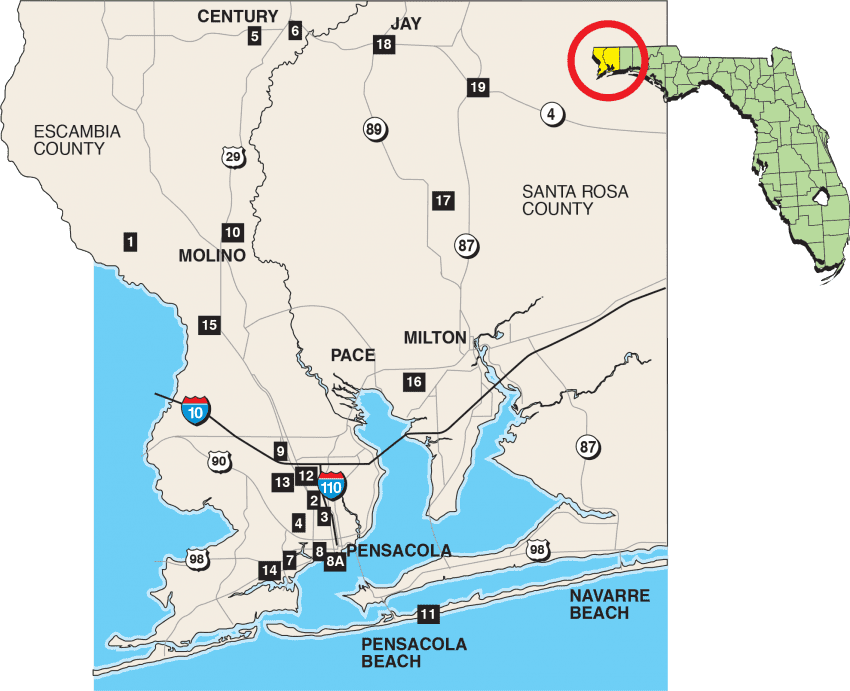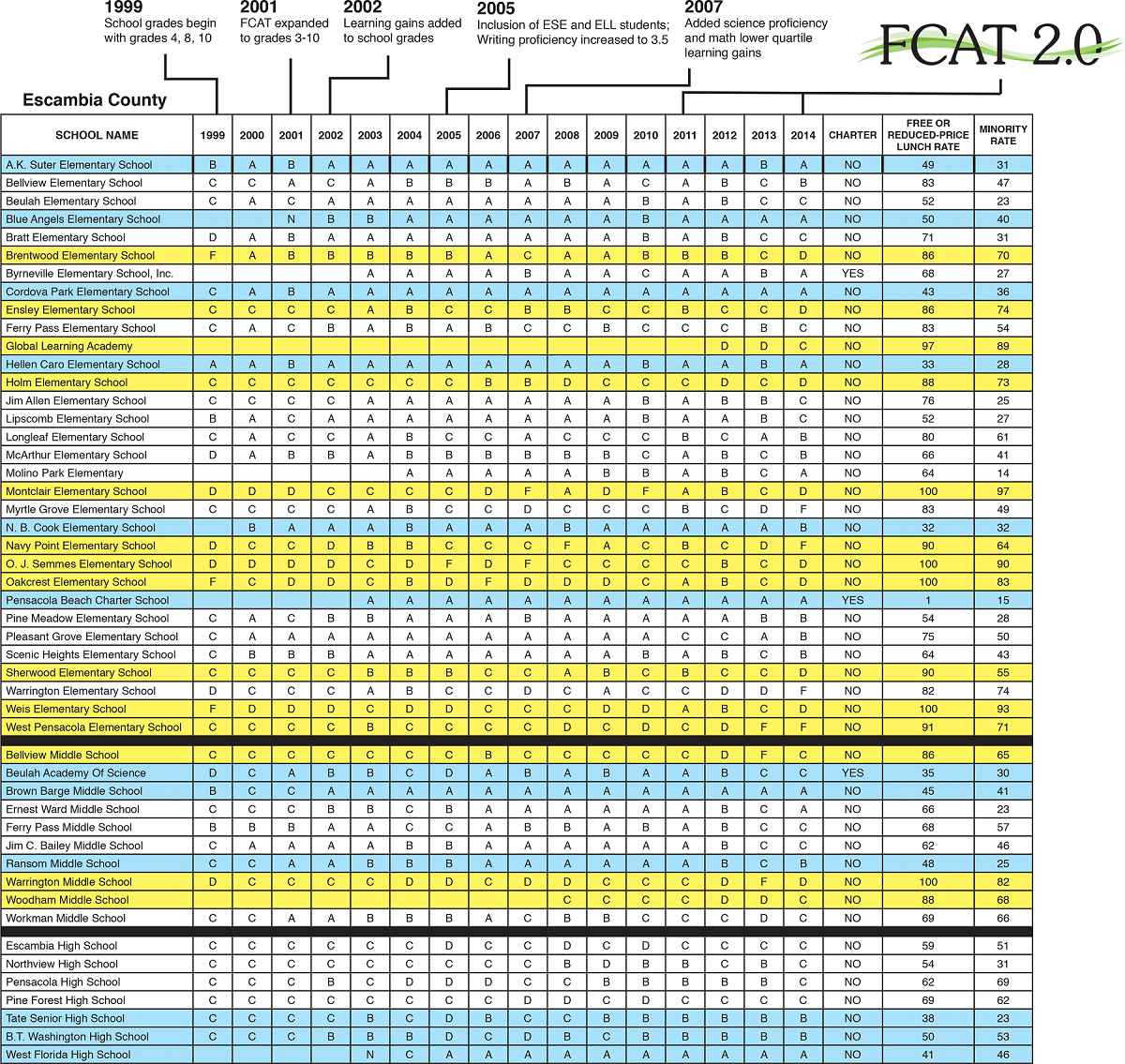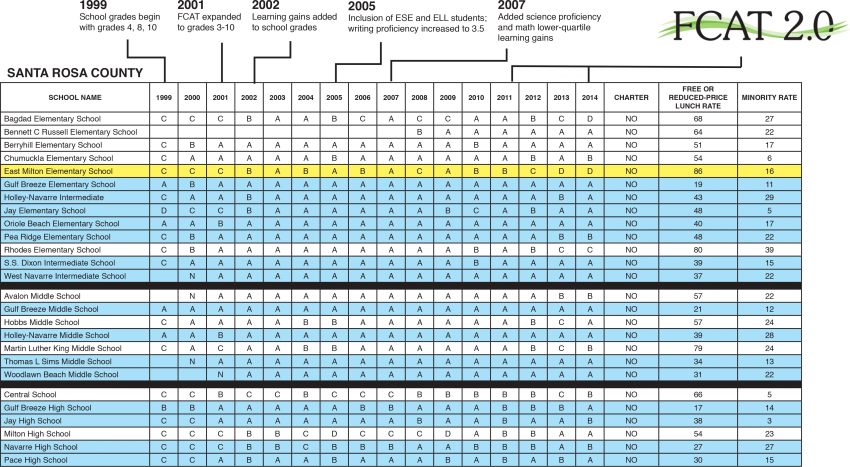
Springtime in Florida means one thing — FCAT. But this year, the Florida Comprehensive Assessment Test — the test used to measure students’ learning gains and to evaluate teacher performance — is not the test it used to be.
The official state standardized test is now the Florida Standards Assessment. The new test replaces the previous versions of the state standardized test and will measure students’ performance based on a curriculum Florida schools have been using in recent years that is similar to the nationally mandated Common Core standards.
As Florida schools turn to the new test, administrators will be left with 16 years of data accumulated in the FCAT era, which was a centerpiece of former Gov. Jeb Bush’s push to reform public schools.
The Studer Community Institute launched this series of stories to look at how Pensacola metro-area schools had fared under that reform effort, the bright spots that were unveiled and the work that remains ahead to help our students, our schools and our community improve.
This is the first of a three-part look at what we found.
Timeline
-
1998
The Florida Department of Education implements the FCAT statewide.
-
1999
Under Gov. Jeb Bush’s A-plus plan, the FCAT expands to include grades three through 10.
-
2000
Letter grades are given to public schools based on student performance on the reading, writing and math sections of the FCAT.
-
2003
Students are required to pass the FCAT to graduate from high school and receive a standard diploma. FCAT science was administered for the first time to fifth-, eighth- and 10th-graders.
-
2006
FCAT Writing exam is expanded to include a multiple-choice section in addition to essay.
-
2008
The FCAT no longer is the main factor to determine high school grades. Lawmakers remove the writing, multiple-choice section and a test that compared Florida students to other across the county to save money.
-
2009
Budget cuts lead to the elimination of summer retakes and a portion of the science FCAT.
-
2010
FCAT math and science is phased out at the high school level and replaced with End-of-Course exams.
-
2011
FCAT 2.0, Next Generation Sunshine State Standards, ushers in a new, more rigorous test. New standards that require higher passing scores become effective with the spring 2012 FCAT.
-
2012
State Board of Education lowers the passing score on the FCAT writing test after the passing rate dropped after changes to FCAT writing in 2011.
-
2014
The FCAT is phased out in favor of a new assessment aligned with state Common Core standards.
-
2015
Students in April will take the Florida Standards Assessment, the state’s new accountability test based on the new Common Core Standards.
How schools have changed since FCAT
When the Florida Comprehensive Assessment Test was used to grade public schools in 1999, the only schools in the state of Florida to earn F’s were in Pensacola’s inner city.
Spencer Bibbs Elementary School on North Sixth Avenue and A.A. Dixon Elementary School on North H Street gained national media attention in that first year, especially given the high profile then-Gov. Jeb Bush had on the political scene.
FCAT was a centerpiece of Bush’s plan to increase accountability and reform public education in Florida. That plan included a voucher system that would give parents at “failing” schools tax dollars to spend at a private school of their choice for their child to attend.
Spencer Bibbs closed in 2011 as a public school, when it received a C. Its students were redistricted into other schools. The building now is being converted into a training space for district staff and teachers.
A.A. Dixon remained a public school until 2002. The building was used by other groups as a charter school, but none of those thrived. It reopened in 2011 as a charter school, A.A. Dixon Charter School of Excellence, when it received an F on state standardized tests. It is now a private school.
Many other schools have closed or been reconfigured in the FCAT era.
It is important to reiterate that in every case except the charter conversions, each of the closures had all students placed in a superior, more modern, more technologically advanced facility,” said Escambia Superintendent Malcolm Thomas.
“These changes were not related to school grades but rather consolidation and replacement of aging, underutilized facilities.”

Escambia County
1 Barrineau Park Elementary: Closed as a public school after the 2003 school year, when it earned an A. It was consolidated into Molino Park Elementary School, which earned a B in 2014. It was presented to the Barrineau Park Historical Society, which continues to use the building.
2 Brentwood Middle: Closed as a public school in 2007, when it earned a C. It is now the home of Brown-Barge Middle School.
3 Brown-Barge Middle: Moved from its Fairfield Drive location, which was turned into an overnight storage area for school buses. It was reopened in current location on Hancock Lane.
4 Brownsville Middle: Closed in 2007, when it earned a C. The building is vacant. The district is considering a purchase offer by GSI Recycling, which owns a scrapyard across the street. The same family also owns Scrap Inc., a car crushing facility just behind the scrapyard.
5 Bryneville Elementary: Closed as a public school in 2002, when it earned a D. It was reconstituted as a charter school. It earned an A last year.
6 Century Elementary: Closed in 2002, when it earned an F. Reconstituted as Carver-Century K-8 School, combined with Carver Middle School in 2003. Carver-Century closed in 2009 with an F. The Carver Middle building is being leased to Pensacola State College to offer classes in Century.
7 Edgewater Elementary: Closed in 2009 when it earned a C. The building was sold to S.L. Jones, a private school.
8 Hallmark Elementary: Closed in 2011, when it earned a D, along with Allie Yniestra. The student populations were combined into Global Learning Academy, which earned a C in 2014. The Hallmark building on F Street was bought by developer Matt Pair in 2013.
8a Allie Ynietra: Closed in 2011, when it earned a C. Yniestra’s students were sent to the new Global Learning Academy, which earned a C in 2014. A plan last year to lease the school, on North Q and Jackson streets, to Remnant Church of Deliverance Christian Academy Inc. fell through. It is vacant.
9 Lincoln Park Elementary: Earned a D in 2011, it was nearly closed because of low enrollment. The school was converted to a primary school, serving students in grades K-2. It no longer receives a state grade. Third-, fourth- and fifth-graders were redistricted to various other schools.
10 Molino Elementary: Closed in 2003 when it earned an A. The students were redistricted to the new Molino Park Elementary School. The old building was sold to the county for use as a community center.
11 Pensacola Beach Elementary: Closed as a public school in 2001. Reopened as a public charter school in 2002. It received an A in 2014.
12 Woodham High: Closed as a public high school in 2007, when it earned a D. Reopened as a middle school in 2008. It received a C in 2014. Long-term district plans call for breaking it up as a middle school, redistricting the students to a yet-to-be-built new middle school and existing schools, and relocating West Florida High School to the Woodham campus.
13 Wedgewood Middle: Closed as a public school in 2007. The building was turned into a community center.
14 A.V. Clubbs: Closed in 2010 as an alternative middle school. Students were relocated first to E-SEAL, which became Camelot Academy on Patton Road. It serves the E-SEAL and previous Clubbs students.
15 Sid Nelson School: Closed in 2010. The building on Muscogee Road was razed. The property is being used for bus parking. The preschool program and the alternative school programs were relocated to other district schools.
Santa Rosa County
16 Bennett C. Russell Elementary: Opened in 2007-2008 school year. It earned a B its first year and has been an A since.
17 Central School: Became a combination K-12 school in 2002.
18 Jay High: Became a combination 7-12 school in 2002. Jay Elementary housed students in grades K-6.
19 Munson Elementary: Closed in 2009, when the school on Munson Highway in Milton earned an A. It is vacant and for sale. Part of it is a community park. Some of it is leased out for reunions, the Blackwater Heritage Festival, training of emergency personnel and other events, said Superintendent Tim Wyrosdick.


Changing test scores
Florida began issuing school grades based on test results on the Florida Comprehensive Assessment Test scores in 1999.
In the beginning, the FCAT evaluated students in grades four, eight and 10. Now students are tested in every grade from three through 10, including reading, math, writing and science.
Over time the test has changed significantly. This chart aims to highlight those changes, as well as track the grades that schools in Escambia and Santa Rosa counties have earned over the years.
Schools whose grades are highlighted in yellow have a poverty rate (as measured by the percentage of students eligible for free or reduced-price lunch) above 85 percent. Those schools typically earn lower grades.
Schools that are highlighted in blue have a poverty rate of 50 percent or below. They earn higher grades.
Glossary
2011-2014
Beginning in 2011, the test was revised to FCAT 2.0. That revision included the addition of new subject tests and data points, new calculations to determine what counts as passing, and standards for achieving proficiency at grade level. Here is a list of the changes in calculating student scores and school grades.
- New cut scores for reading (grades 3-10)
- New cut scores for math (grades 3-8)
- Algebra End-of-Course cut scores
- Added geometry End-of-Course exam
- Added biology End-of-Course exam
- Added U.S. history End-of-Course exam
- New learning gain calculation for reading (grades 3-10)
- New learning gain calculation for math (grades 3-8)
- Add special education students to proficiency for reading (grades 3-10)
- Add special-education students to proficiency for math (grades 3-8)
- Add English-as-a-second-language students to proficiency for reading (grades 3-10)
- Add English-as-a-second-language students to proficiency for math (grades 3-8)
- Reweight middle school participation/acceleration
- Include special-education alternate assessment students in grade calculation
- Add special-education alternate assessment to gains calculation
- Include four-year federal graduation rate (excludes special diploma students)
- Include five-year modified graduation rate (includes special diploma students)
- Change cut for at-risk graduation rate
- Change cell size for grade calculation from 30 to 10
- Add reading threshold for passing grade (25 percent)
- Remove students in level three from lower quartile reading calculation
- Remove students in level three from lower quartile math calculation
- Weight learning gains for students moving level four and five
- Add middle school acceleration component
- Writing scoring rubric revised (grades 4, 8, 10)
- Writing proficiency score set at 4
- Writing proficiency score changed to 3
- Writing proficiency score changed to 3.5
- Special education center students scored count at attendance zone school
- New FCAT 2.0 assessment for reading
- New FCAT 2.0 assessment for math
- New FCAT 2.0 assessment for science
- Revised middle school grade scale
In this report
-
Male teacher in class asking students a question
From troubled FCAT to an untested replacement
by Reggle Dongan
In 1977, Florida became the first state in the U.S. to use a standardized test for high school graduation. Two decades later, the FCAT was introduced in 1998, the year before Gov. Jeb Bush was elected.
-
FCAT paper test image
The miseducation of the FCAT generation
by Shannon Nickinson
Call it the tale of the tape. Or rather the tale of the test. In researching this series of education-themed stories, my colleagues and I have been looking at what 16 years of state standardized testing in Florida has brought schools in Escambia and Santa Rosa schools.
-
Sam Mathews at his desk
Parents find a way to help their children learn
by Reggle Dongan
When the state Department of Education released FCAT grades in 1999, the good news was that only two elementary schools received failing scores. The bad news: Both of them — Spencer Bibbs and A.A. Dixon — were in Escambia County.
-
State Senator Don Gaetz
Skills, not just degree levels, affect graduate wages
by Rick Harper
In 2012, State Sen. Don Gaetz passed legislation requiring Florida’s Department of Economic Opportunity to report annually on the wages earned by recent graduates of the many programs offered by our public colleges, universities and technical schools.
Coming Up in Part 2:
Schools that work
In the next edition of Pensacola Metro Report on education, we highlight “bright spots” that are providing a quality education far and near. Hundreds of miles northeast of Pensacola, North Charleston High School in South Carolina has shown some of the highest gains in test scores and graduation rates in the state. With a minority enrollment of 95 percent, and nearly all students eligible for free-or reduced-lunch price meals, North Charleston is shining a bright light in education.
At home, West Florida High School is Escambia County’s only consistent “A”-rated school, with test scores and graduation rates that are higher than all other county high schools. While the School District’s overall graduation rate reached 66 percent last year, West Florida’s graduation rate — at 94 percent — is one of the highest in the U.S.
The Institute’s second edition was released Sunday, Feb. 22, in the Pensacola News Journal.
Coming Up in Part 3:
Building a better reader
Experts agree that the key to building a good student is building a strong reader.
Increasingly, research suggests a pivotal time to influence a child’s reading ability is ages 0-3, which is often long before a child enters a classroom.
In the third installment of the Studer Community Institute’s education report, we looked at the growing body of research that supports the importance of early learning, the importance of getting parents involved in the learning process at all ages, and at two programs working now in the Pensacola metro area to help bridge that gap.
Join Our Newsletter